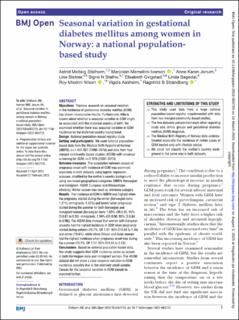| dc.contributor.author | Stalheim, Astrid Melteig | |
| dc.contributor.author | Iversen, Marjolein M. | |
| dc.contributor.author | Jenum, Anne Karen | |
| dc.contributor.author | Sletner, Line | |
| dc.contributor.author | Stafne, Signe Nilssen | |
| dc.contributor.author | Qvigstad, Elisabeth | |
| dc.contributor.author | Sagedal, Linda Reme | |
| dc.contributor.author | Nilsen, Roy Miodini | |
| dc.contributor.author | Aasheim, Vigdis | |
| dc.contributor.author | Strandberg, Ragnhild Bjarkøy | |
| dc.date.accessioned | 2023-08-29T10:45:00Z | |
| dc.date.available | 2023-08-29T10:45:00Z | |
| dc.date.created | 2023-03-31T12:16:22Z | |
| dc.date.issued | 2023 | |
| dc.identifier.citation | BMJ Open. 2023, 13 (3), 1-8. | en_US |
| dc.identifier.issn | 2044-6055 | |
| dc.identifier.uri | https://hdl.handle.net/11250/3086166 | |
| dc.description.abstract | Objectives Previous research on seasonal variation in the incidence of gestational diabetes mellitus (GDM) has shown inconclusive results. Furthermore, little is known about whether a seasonal variation in GDM might be associated with the maternal country of birth. We examined whether there was seasonal variation in GDM incidence by the maternal country background. Design National population-based registry study. Setting and participants We used national population-based data from the Medical Birth Registry of Norway (MBRN), n=1 443 857 (1990–2016) and data from four merged community-based studies (4GDM) with universal screening for GDM, n=2 978 (2002–2013). Outcome measures The association between season of pregnancy onset with incidence of GDM was examined separately in both datasets using logistic regression analyses, stratified by the mother’s country background using two broad geographical categories (MBRN: Norwegian and immigrant; 4GDM: European and African/Asian ethnicity). Winter season was used as reference category. Results The incidence of GDM in MBRN was highest when the pregnancy started during the winter (Norwegian-born: 1.21%; immigrants: 3.32%) and lowest when pregnancy started during the summer for both Norwegian and immigrant women (Norwegian-born: 1.03% (OR 0.85, 95% CI 0.81 to 0.98); immigrants: 2.99% (OR 0.90, 95% CI 0.84 to 0.96)). The 4GDM data showed that women with European ancestry had the highest incidence of GDM when pregnancy started during autumn (10.7%, OR 1.01, 95% CI 0.69 to 1.46) and winter (10.6%), while ethnic African and Asian women had the highest incidence when pregnancy onset was during the summer (15.3%, OR 1.17, 95% CI 0.54 to 2.53). Conclusions Based on national population-based data, this study suggests that GDM incidence varies by season in both Norwegian-born and immigrant women. The 4GDM dataset did not show a clear seasonal variation in GDM incidence, possibly due to the relatively small sample. Causes for the seasonal variation in GDM should be explored further. | en_US |
| dc.language.iso | eng | en_US |
| dc.publisher | BMJ | en_US |
| dc.rights | Navngivelse-Ikkekommersiell 4.0 Internasjonal | * |
| dc.rights.uri | http://creativecommons.org/licenses/by-nc/4.0/deed.no | * |
| dc.title | Seasonal variation in gestational diabetes mellitus among women in Norway: a national population-based study | en_US |
| dc.title.alternative | Seasonal variation in gestational diabetes mellitus among women in Norway: a national population-based study | en_US |
| dc.type | Peer reviewed | en_US |
| dc.type | Journal article | en_US |
| dc.description.version | publishedVersion | en_US |
| dc.source.pagenumber | 1-8 | en_US |
| dc.source.volume | 13 | en_US |
| dc.source.journal | BMJ Open | en_US |
| dc.source.issue | 3 | en_US |
| dc.identifier.doi | 10.1136/bmjopen-2022-063725 | |
| dc.identifier.cristin | 2138829 | |
| cristin.ispublished | true | |
| cristin.fulltext | original | |
| cristin.qualitycode | 1 | |

